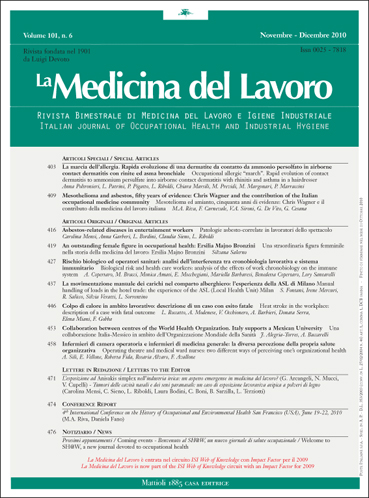La movimentazione manuale dei carichi nel comparto alberghiero: l’esperienza della ASL di Milano / Manual handling of loads in the hotel trade: the experience of the ASL (Local Health Unit) Milan
Contenuto principale dell'articolo
Keywords
Lifting Index (LI), manual handling, room staff, hotel trade staff
Abstract
Il Servizio P.S.A.L. dell’ASL di Milano ha avviato dal 2008 un’indagine nel comparto alberghiero con lo scopo di contribuire al miglioramento della conoscenza delle condizioni d’igiene e sicurezza e alla realizzazione di interventi di prevenzione. In Milano sono ubicati circa 400 tra hotels e alberghi con un’offerta di circa 62000 posti letto e circa 10000 addetti. L’analisi condotta sulle informazioni contenute nei registri infortuni suggerisce che un numero significativo d’infortuni si possono correlare con patologie muscoloscheletriche che colpiscono prevalentemente personale di pulizia, di fatica e di cucina. Nei sopralluoghi e nelle valutazioni delle strutture ricettive sono stati utilizzati gli strumenti oggi disponibili – Lifting Index, Analisi per il traino e spinta dei carrelli e Check-List OC.R.A. – per lo studio della movimentazione manuale dei carichi e della movimentazione ripetuta, che hanno dimostrato l’esistenza di un rischio professionale specifico a carico delle mansioni citate e come si rendano opportune nuove riflessioni nell’approccio alla prevenzione e sicurezza dell’intero settore.
Manual handling of loads in the hotel trade: the experience of the ASL (Local Health Unit) Milan
Background: There are over 400 hotels in Milan with a guest capacity of about 62000 and employing more than 10000 workers. In 2008/09 the Occupational Health and Safety Service of A.S.L. Milano (Local Health Unit) carried out research into the hotel trade to ascertain the development of this commercial sector, also in view of EXPO 2015. Objectives: The aim of the project was to improve hygiene and safety conditions and carry out preventive measures. A specific purpose was to study manual handling of loads and repetitive movements risk. Method: The study covered 30 hotels and 7 temporary staff cooperatives. We acquired the Risk Evaluation Document, the Health Surveillance Programme and Registers of Labour Accidents to analyze manual handling of loads and repetitive movements. In the investigations and assessments on hotels we used currently available scientific tools – NIOSH Lifting Index, Push and Pulling Analysis, OC.R.A. Check-List – to study risks related to handling loads and upper limb mechanical overload, which revealed a specific occupational risk that requires a fresh approach to prevention and safety in the entire sector. Results: Chambermaid: LI (Range): 0.57-2.75; Push and Pulling Actions: Fi 0.66-Fm 1.5 and Fi 0.76-Fm 1.33 respectively; OC.R.A. Check-List: 21. Porter: LI (Range): 0.77-3.75. Maintenance staff: LI (Range): 0.57-2.75. Conclusions: The study highlighted the presence of risk due to manual handling of loads and repetitive movements in porters, maintenance personnel and particularly in chambermaids that up to now have been poorly assessed by safety experts. Analysis of the information contained in the registers of labour accidents suggests that a significant number of accidents can be related to muscular-skeletal disorders that affect especially cleaning, portering and kitchen staff.






